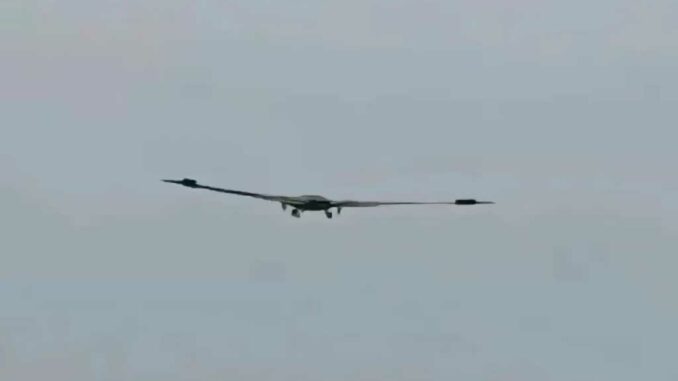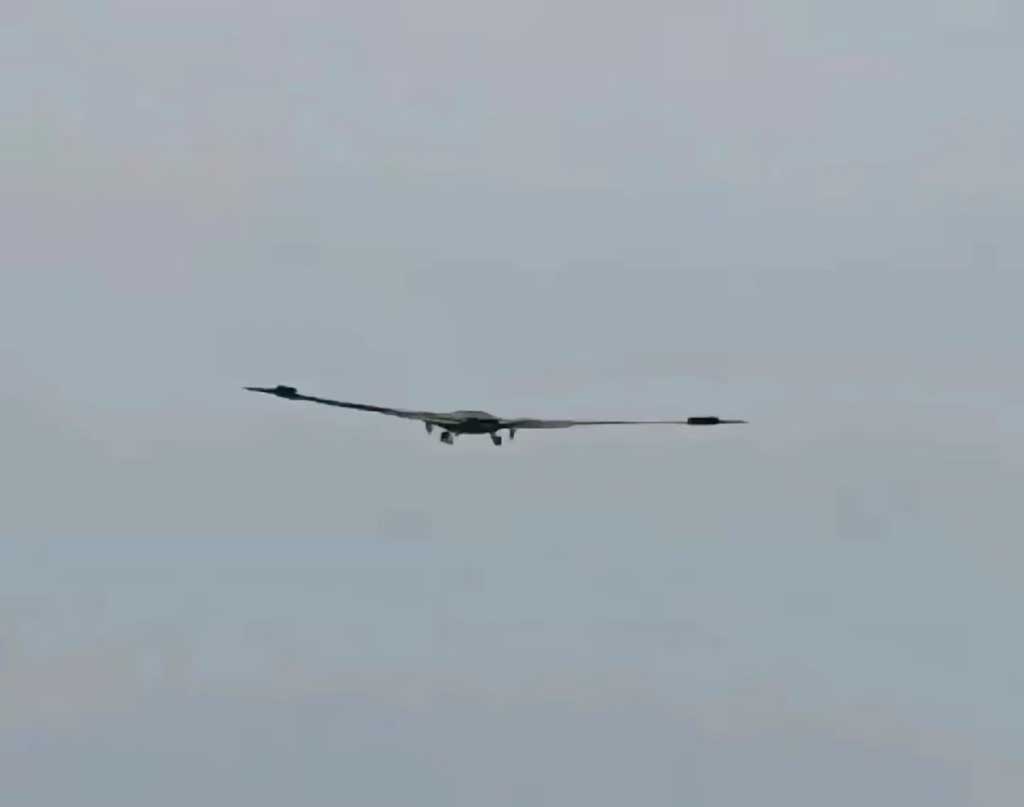
A gigantic stealth drone, designated WZ-X, has been spotted flying in China. Its dimensions, comparable to those of the American B-2, raise strategic issues.
A recent image shows a Chinese flying wing stealth drone of exceptional size, probably the WZ-X, already observed by satellite at the Malan base in Xinjiang in May 2025. Its estimated wingspan of 52 meters is close to that of the B-2 Spirit stealth bomber. This type of aircraft belongs to the HALE (High-Altitude Long-Endurance) category and is mainly used for strategic intelligence missions. The public appearance of this photo, a few weeks before the September 3 military parade in Beijing, confirms the acceleration of Chinese aviation programs and raises concerns about the Indo-Pacific military balance.
Technical description of the drone in flight
The image shows a massive aircraft in flying wing configuration. The landing gear is clearly visible, as are split rudders on the wing tips, a feature already used on the American B-2. The structure combines the wing and fuselage into a single unit, with a wide, flattened central section. No cockpit is visible, suggesting that this is indeed a drone, but the presence of a cockpit cannot be completely ruled out.
The aircraft’s wingspan is estimated at 170 feet, or 52 meters, which places it in the same category as the B-2 Spirit (52.4 m). The size of the landing gear compared to the overall structure confirms the monumental scale of the aircraft. At the rear, rectangular exhaust outlets can be seen, suggesting a twin-engine system.
These characteristics suggest that this drone belongs to the HALE category, designed to fly at high altitudes for several dozen hours. The very elongated wings favor lift and endurance, an essential asset for surveillance missions covering vast areas such as the South China Sea or the Pacific Ocean.
Comparison with other Chinese drones
China has been developing a wide range of drones for several years. The best-known stealth project is the CH-7, a drone also in a flying wing configuration, but with a wingspan much smaller than that of the WZ-X. The CH-7 has a thicker, curved central section, while the WZ-X appears flatter and more elongated.
The WZ-7 Soaring Dragon has a joined wing configuration and a wingspan of around 25 meters, half that of the WZ-X. It is already carrying out intelligence missions as part of surveillance of the seas bordering China. The WZ-9 Divine Eagle, characterized by its double fuselage connected by a central wing, is designed to detect air targets, particularly enemy stealth aircraft. Its 35-hour endurance makes it a powerful tool, but its dimensions are still far behind those of the drone observed in May 2025.
These comparisons highlight one clear fact: no known Chinese aircraft can rival the WZ-X in size. It therefore represents a qualitative leap forward in the Chinese stealth drone category. Its size, close to that of a strategic bomber, suggests a significant internal payload capacity for sensors, radars, and long-range communication antennas.
The strategic challenges of a stealth HALE platform
A stealth HALE drone such as the WZ-X could transform China’s strategic intelligence capabilities. Its autonomy, estimated at 30 to 40 hours of flight time, and its range of over 5,000 km, enable it to cover an area as far as Guam, where key US bases are located.
For Beijing, this type of drone offers several advantages. It complements China’s space network by providing real-time data without relying solely on satellites, which are vulnerable to anti-satellite weapons. Thanks to its stealth capabilities, it can penetrate deeper into enemy airspace than a conventional drone, gathering information on fleet or troop movements.
The US military fears that these aircraft could be used to guide long-range strike systems, such as the DF-21D or DF-26 anti-ship ballistic missiles, capable of targeting an aircraft carrier from more than 2,000 km away. With constant surveillance provided by a stealthy HALE drone, the US forces’ reaction time would be significantly reduced.
In other words, the WZ-X is not just an intelligence tool: it is a force multiplier for Chinese long-range weapons.

International comparisons
The development of the WZ-X is reminiscent of other foreign programs. In the US, the RQ-180, developed by Northrop Grumman, remains largely classified. Its wingspan, estimated at between 40 and 45 m, is smaller than that of the Chinese drone, but its mission is similar: to carry out discreet surveillance operations in the most heavily defended areas. The US budget for strategic drones has regularly exceeded $1 billion per year since 2018.
Russia is banking on the S-70 Okhotnik-B, a smaller stealth drone with a wingspan of around 20 m and a weight of 20 tons. Designed to work in cooperation with the Su-57, it is closer to an attack drone than a HALE platform.
China is unique in having designed a drone as large as a bomber, entirely dedicated to reconnaissance. This confirms Beijing’s priority for long-range aerial intelligence, in line with its rivalry with Washington.
Regional consequences in the Indo-Pacific
The introduction of a drone such as the WZ-X alters the military balance in Asia. Its range covers not only the South China Sea but also the western Pacific. This places US deployments in Guam, as well as the airspace of Japan and northern Australia, under direct surveillance.
Japan, already engaged in a military modernization program worth more than $40 billion over five years, is investing heavily in missile defense to counter these threats. Australia, with the AUKUS agreement, is moving toward nuclear submarines and advanced detection systems to rebalance the situation.
These drones increase psychological and operational pressure. US forces must now factor in the possibility of constant surveillance, which reduces their freedom of maneuver and increases their operating costs. The WZ-X thus acts as an indirect deterrent, even before entering active service.
Industrial and technological prospects
Building a stealth drone with a wingspan of over 50 meters requires industrial capacity close to that needed to produce commercial aircraft. China can rely on AVIC and other large aerospace conglomerates. The use of absorbent materials and special coatings remains costly: in the United States, maintaining a single B-2 costs around $10 million per year just to maintain its stealth capabilities. Beijing must therefore have developed industrial processes to reduce maintenance costs in order to consider mass production.
The global market for military drones is estimated at $30 billion in 2025, with nearly 40% for surveillance and intelligence systems. China is not only targeting domestic use: some analysts believe that in the medium term, it could offer export versions of its HALE drones, particularly to Pakistan and Iran.
If this is confirmed, Beijing would become the only country after the United States to have a fleet of stealth drones of this size, reinforcing its status as a major player in the military aviation industry.
Possible scenarios for the future
Three scenarios are emerging for the WZ-X.
- A single demonstrator: intended to validate technological choices. In this case, the operational threat would remain limited but would demonstrate China’s ambition.
- A small fleet: around ten units used for strategic reconnaissance. This scenario would strengthen Beijing’s independence in terms of intelligence.
- Mass production: several dozen units integrated into a C4ISR network. In this case, the regional military balance would be profoundly altered.
In each scenario, China is demonstrating that it is moving quickly. Even without certainty about the exact number of aircraft built, the mere dissemination of these images is already a strategic signal to its rivals.
War Wings Daily is an independant magazine.